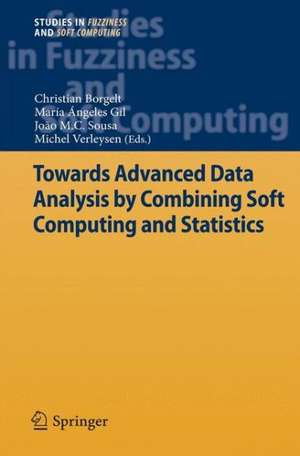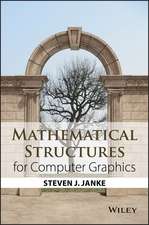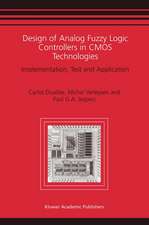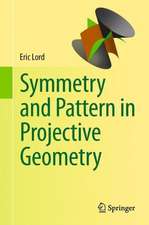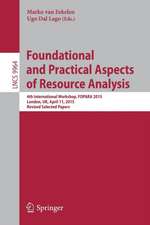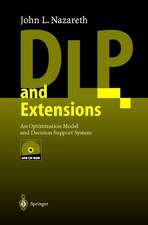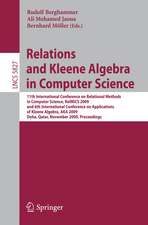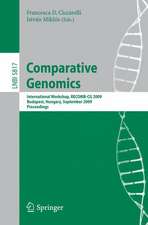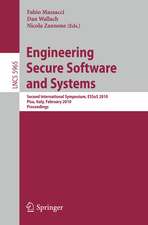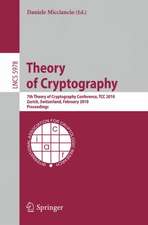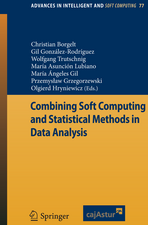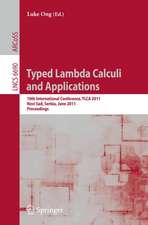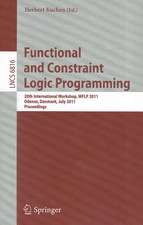Towards Advanced Data Analysis by Combining Soft Computing and Statistics: Studies in Fuzziness and Soft Computing, cartea 285
Editat de Christian Borgelt, María Ángeles Gil, João M.C. Sousa, Michel Verleysenen Limba Engleză Paperback – 20 sep 2014
Soft computing focuses on obtaining working solutions quickly, accepting approximations and unconventional approaches. Its strength lies in its flexibility to create models that suit the needs arising in applications. In addition, it emphasizes the need for intuitive and interpretable models, which are tolerant to imprecision and uncertainty.
Statistics is more rigorous and focuses on establishing objective conclusions based on experimental data by analyzing the possible situations and their (relative) likelihood. It emphasizes the need for mathematical methods and tools to assess solutions and guarantee performance.
Combining the two fields enhances the robustness and generalizability of data analysis methods, while preserving the flexibility to solve real-world problems efficiently and intuitively.
| Toate formatele și edițiile | Preț | Express |
|---|---|---|
| Paperback (1) | 991.60 lei 6-8 săpt. | |
| Springer Berlin, Heidelberg – 20 sep 2014 | 991.60 lei 6-8 săpt. | |
| Hardback (1) | 998.04 lei 6-8 săpt. | |
| Springer Berlin, Heidelberg – 29 aug 2012 | 998.04 lei 6-8 săpt. |
Din seria Studies in Fuzziness and Soft Computing
- 20%
 Preț: 999.85 lei
Preț: 999.85 lei - 20%
 Preț: 653.06 lei
Preț: 653.06 lei - 20%
 Preț: 872.96 lei
Preț: 872.96 lei - 20%
 Preț: 930.57 lei
Preț: 930.57 lei - 20%
 Preț: 1051.00 lei
Preț: 1051.00 lei - 20%
 Preț: 992.44 lei
Preț: 992.44 lei - 20%
 Preț: 655.85 lei
Preț: 655.85 lei - 20%
 Preț: 1001.86 lei
Preț: 1001.86 lei - 18%
 Preț: 954.14 lei
Preț: 954.14 lei - 20%
 Preț: 330.10 lei
Preț: 330.10 lei - 20%
 Preț: 333.04 lei
Preț: 333.04 lei - 20%
 Preț: 997.56 lei
Preț: 997.56 lei -
 Preț: 391.61 lei
Preț: 391.61 lei - 20%
 Preț: 647.79 lei
Preț: 647.79 lei - 20%
 Preț: 986.01 lei
Preț: 986.01 lei - 18%
 Preț: 958.56 lei
Preț: 958.56 lei - 20%
 Preț: 996.40 lei
Preț: 996.40 lei - 20%
 Preț: 999.35 lei
Preț: 999.35 lei - 15%
 Preț: 646.43 lei
Preț: 646.43 lei - 20%
 Preț: 651.57 lei
Preț: 651.57 lei - 20%
 Preț: 997.89 lei
Preț: 997.89 lei - 15%
 Preț: 641.03 lei
Preț: 641.03 lei - 20%
 Preț: 1009.74 lei
Preț: 1009.74 lei - 20%
 Preț: 992.62 lei
Preț: 992.62 lei -
 Preț: 388.72 lei
Preț: 388.72 lei - 18%
 Preț: 1223.43 lei
Preț: 1223.43 lei - 20%
 Preț: 651.42 lei
Preț: 651.42 lei - 18%
 Preț: 951.59 lei
Preț: 951.59 lei - 18%
 Preț: 948.61 lei
Preț: 948.61 lei
Preț: 991.60 lei
Preț vechi: 1239.50 lei
-20% Nou
Puncte Express: 1487
Preț estimativ în valută:
189.74€ • 198.64$ • 156.100£
189.74€ • 198.64$ • 156.100£
Carte tipărită la comandă
Livrare economică 05-19 aprilie
Preluare comenzi: 021 569.72.76
Specificații
ISBN-13: 9783642443749
ISBN-10: 3642443745
Pagini: 388
Ilustrații: X, 378 p.
Dimensiuni: 155 x 235 x 20 mm
Greutate: 0.54 kg
Ediția:2013
Editura: Springer Berlin, Heidelberg
Colecția Springer
Seria Studies in Fuzziness and Soft Computing
Locul publicării:Berlin, Heidelberg, Germany
ISBN-10: 3642443745
Pagini: 388
Ilustrații: X, 378 p.
Dimensiuni: 155 x 235 x 20 mm
Greutate: 0.54 kg
Ediția:2013
Editura: Springer Berlin, Heidelberg
Colecția Springer
Seria Studies in Fuzziness and Soft Computing
Locul publicării:Berlin, Heidelberg, Germany
Public țintă
ResearchCuprins
From the Contents: Arithmetic and Distance-Based Approach to the Statistical Analysis of Imprecisely Valued Data.- Linear Regression Analysis for Interval-valued Data Based on Set Arithmetic: A Bootstrap Confidence Intervals for the Parameters of a Linear Regression Model with Fuzzy Random Variables.- On the Estimation of the Regression Model M for Interval Data.- Hybrid Least-Squares Regression Modelling Using Confidence.- Testing the Variability of Interval Data: An Application to Tidal Fluctuation.-Comparing the Medians of a Random Interval Defined by Means of Two Different L1 Metrics.-Comparing the Representativeness of the 1-norm Median for Likert and Free-response Fuzzy Scales.-Fuzzy Probability Distributions in Reliability Analysis, Fuzzy HPD-regions, and Fuzzy Predictive Distributions.
Recenzii
From the reviews:
“This excellent volume will serve as an introduction to an important merging of viewpoints. The papers are generally very good and the text is clear and readable. The mathematical rigor is high and nearly all papers include real-world examples or experimental data. … This book is a valuable resource for those employed in statistical and soft computing, and a useful work for promoting better connections between these two fields.” (Creed Jones, ACM Computing Reviews, December, 2012)
“This excellent volume will serve as an introduction to an important merging of viewpoints. The papers are generally very good and the text is clear and readable. The mathematical rigor is high and nearly all papers include real-world examples or experimental data. … This book is a valuable resource for those employed in statistical and soft computing, and a useful work for promoting better connections between these two fields.” (Creed Jones, ACM Computing Reviews, December, 2012)
Textul de pe ultima copertă
Soft computing, as an engineering science, and statistics, as a classical branch of mathematics, emphasize different aspects of data analysis.
Soft computing focuses on obtaining working solutions quickly, accepting approximations and unconventional approaches. Its strength lies in its flexibility to create models that suit the needs arising in applications. In addition, it emphasizes the need for intuitive and interpretable models, which are tolerant to imprecision and uncertainty.
Statistics is more rigorous and focuses on establishing objective conclusions based on experimental data by analyzing the possible situations and their (relative) likelihood. It emphasizes the need for mathematical methods and tools to assess solutions and guarantee performance.
Combining the two fields enhances the robustness and generalizability of data analysis methods, while preserving the flexibility to solve real-world problems efficiently and intuitively.
Soft computing focuses on obtaining working solutions quickly, accepting approximations and unconventional approaches. Its strength lies in its flexibility to create models that suit the needs arising in applications. In addition, it emphasizes the need for intuitive and interpretable models, which are tolerant to imprecision and uncertainty.
Statistics is more rigorous and focuses on establishing objective conclusions based on experimental data by analyzing the possible situations and their (relative) likelihood. It emphasizes the need for mathematical methods and tools to assess solutions and guarantee performance.
Combining the two fields enhances the robustness and generalizability of data analysis methods, while preserving the flexibility to solve real-world problems efficiently and intuitively.
Caracteristici
The book aims to describe how soft computing and statical methods can be used together to improve data analysis Advances research in soft computing and statical methods for data analysis Written by leading experts in the field
